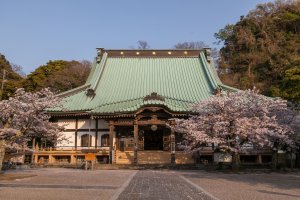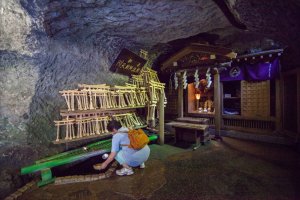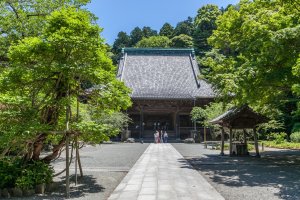Kamakura, just an hour away from Tokyo, is one of the most visited cities in Japan. With beaches, shrines and temples, hiking courses in wooded hills, and the ancient political capital of Japan (1185-1333), Kamakura has a laidback atmosphere rocked by the sound of the waves and the bells of the Buddhist temples. The good news is that you can visit some of the best spots without spending a single yen!
1. BEACHES
Separated by the river Nameri-gawa, Yuigahama (on the right) and Zaimokuza, the beaches span about one kilometer of coastline and are popular getaways in summer. The official swimming season lasts from July to August but the water is warm from June to October.
There are free toilets and outside showers (no soap or shampoo) on each beach.
To get there, turn right at the traffic light straight ahead of the east exit of Kamakura Station, and walk down the main street (Wakamiya- Ōji) for about 20 minutes.
2. KOMYO-JI TEMPLE
Although Kamakura’s most famous Buddhist temples charge a small fee (from 100 to 300 yen), there are some great ones you can visit without spending a single yen (unless you want to do like Japanese people and offer a coin to the Gods before praying!)
Close to Zaimokuza beach, Kōmyō-ji is our favorite. Established in 1243, it became one of the most important temples of the Buddhist Jōdo sect in the Kanto area. Its huge and beautiful wooden gate is designated as an important prefectural cultural asset. The temple is famous for its cherry blossoms in spring and lotus in summer. It has a dry rock-and-sand garden (Karesansui).
From October 12th through to October 15th, the temple hosts a memorial service where the priests chant sutras for three days, 24 hours a day. A night market is set up and attracts a lot of locals.
The temple is open every day from 7am-4pm (5pm in summer). It is 30 minutes walk from Kamakura station (East exit), next to Zaimokuza beach.
3. ENJOY GREAT VIEWS
Just behind Kōmyō-ji temple, there is a path (on the right of the main hall) leading up a hill with great views. On clear days you can see the coast, the nearby Enoshima island, the Izu Peninsula, and Mount Fuji.
4. TSURUGAOKA HACHIMAN-GU SHRINE
A cherry-blossom-lined pathway leads to Kamakura’s biggest and most famous Shinto shrine: Tsurugaoka Hachiman-gu. It was founded by Minamoto Yoriyoshi in 1063 and transferred to its current site in 1180 by his descendant Minamoto no Yoritomo, the shogun and founder of Kamakura. An iconic vermilion torii gate and a steeply curved bridge form the main approach, flanked by two lotus ponds on each side. Dedicated to Hachiman, the Minamoto clan’s patron god, the shrine grounds feature the main hall overlooking the city, a stage where various ceremonies are held, a shrine museum, and various auxiliary buildings.
To get to the shrine, turn left at the traffic light straight ahead of the east exit of Kamakura Station, and after a short walk, you will find a big vermilion torii gate (indicating the entrance of a Shinto shrine) and the cherry-blossom lined path (called Danzakura) leading to Tsurugaoka Hachiman-gu’s second torii. It is opened every day from 5am to 9pm (6am-9pm from October to March)
5. ZENI-ARAI BENTEN SHRINE
Zeni-arai Benten is worth a visit as well. About 20-minute walk from the west exit of Kamakura station, located in hilly surroundings, the ‘Money-Washing Shrine’ is visited by people who want to succeed in business or simply become richer. They come to wash their money (zeni-arai means "coin washing") by pouring the shrine’s holy spring water on their coins or notes and pray for it to double, as the legend goes.
The shrine is a fusion of Buddhism and Shintoism. It is dedicated to both Ugafuku god, a Shinto spirit, and to the Buddhist goddess Benten (also called Benzaiten), the goddess of beauty and also the patron of music and the arts. She is also associated with snakes. So, on the days of the snake (according to the Chinese zodiacal calendar), since the spring water is said to be especially efficacious for multiplying money, crowds are coming from all over Japan to pray the goddess while dipping their notes in the water.
Zeni-arai Benten, located in a cave, has a special and whimsical atmosphere with its tunnel cut into the hillside leading to a jumble of small shrines, ponds, altars, caves, shops and a waterfall. It is opened everyday from 8am to 4:30pm.
6. GIONYAMA HIKING COURSE
Built between the Pacific Ocean and forested hills, Kamakura has some very nice hiking trails. The Gionyama Hiking Course is the shortest. It takes only about 30 minutes to complete and it is a great way to visit some more religious buildings and have nice views of the city.
The trail connects Yagumo Shrine, Myohonji temple (see below) and the Hara-kiri Yagura, a cave tomb where the remains of the last Hojo regent, who committed suicide, are buried.
Yagumo-jinja, a small typical Shinto shrine is located about 600 meters from the southeast of Kamakura station. Turn right at the traffic light straight ahead of the east exit and walk until you see a rail bridge next to a Lawson convenience store.
Go left just before the bridge, then left again at the level crossing. Keep going along this road past a traffic light, then turn left at the signpost to Yagumo Shrine which is on your right. At the right of the main shrine building, there is a little path.The trailhead is just to the right of the rear torii.
7. MYOHONJI TEMPLE
Nestled in a wooded small valley, Myohonji, built in 1260, is the biggest Nichiren Buddhist temple of the city. It features a huge statue of Nichiren, the founder of the Japanese Buddhist Nichiren sect, to the left of the main hall. This huge hall stands out the green background of maple trees, turning red in autumn, and the precincts have a serene atmosphere. It is a must-see temple only within 10 minutes walk from the east exit of Kamakura station. It is open every day from 9am to 5pm.
8. STROLL IN KOMACHI-DORI
Just a stone’s throw from Kamakura station (turn left at the rotary), Komachi-dori is the city’s busiest street. It is lined with souvenir shops, fancy cafes, restaurants and stores selling all kinds of food, from purple yam ice cream to wasabi flavored nuts. Some shops offer free tasting. You will find more shops and a more relaxed atmosphere in the small alleys around this central street.
9. WATCH A FESTIVAL
Kamakura boasts many great and authentic festivals all year around. Kamakura Festival (2nd and 3rd Sunday of April) and the 800-year old Reitaisai festival of Tsurugaoka Hachiman-gu shrine (15th and 16th September) are the most famous. All the events are entirely free. You can assist to ritual dances, parades portable shrine and yabusame - horseback archery in Tsurugaoka Hachiman shrine’s precincts.
10. ENJOY THE SUNSET FROM INAMURAGASAKI PARK
To end your day of free visits, walk up to Inamuragasaki Park (10 minutes walk from Inamuragaski Enoden station, exit and head left towards the beach, the park is on the left on a hill). There, you can enjoy a picnic or a drink with stunning ocean view and sunset on Enoshima Island and Mt Fuji on clear days.


































